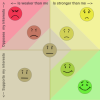Hi, i just stumbled across this project today. I'd like to see some Voxel crafters go in a bit more original direction as you are trying to do.
Some thoughts about the Theme and Backstory:
IMHO the best experience comes about when the Theme/Backstory of the game and the gameplay integrate seamlessly.
I copied some bullet points from the wiki, that i think are relevant:
- • Minion management akin to Dwarf Fortress or Dungeon Keeper - creatures that will have needs that take up space to provide that then in return provide you with various benefits. This helps fill out the world.
• Crafting more focused on realistic workshops improving quality and quantity based on upgrades, specific minions, etc
• A more vivid world that's alive and changes over time, even without direct manipulation by the player
• Autonomous NPC societies that grow on their own and can both be source of minions as well as valuable trading partners. Or be your greatest enemy...
It seems like NPC minions are going to be a big part of this game. One of the problems with NPCs, especially in an arbitrary 3D world, is that it is extremely hard to make them seem like intelligent, thinking beings, when they cope badly with the world around them. If these NPCs look human (more or less) it is hard to care about them, when their actions are such bad imitations of humanity.
However, there's way to deal with these shortcomings -- don't make them human, or even humanoid. Players are much more sensitive to uncanny/odd/stupid behavior, when humans are supposed to be doing it. We know how humans act. And we expect humanoids to act pretty similarly. We are much more forgiving of odd behavior from non-humanoid robots and critters etc. We have fewer strong expectations about how they will behave. My dog will happily do the same thing every day, with the same enthusiasm. Going outside never gets old. If an adult person acted that way, it would be disconcerting.
So populate the world with non-humanoid critters who are simple-minded. Present them as having an intellect somewhere between that of a dog and a human child. To drive it home, perhaps make most of them shorter than the players. Don't make these critters speak English. "Humans" quickly seem phony when they repeat the same phrases with the same inflection. They can chirp, bray, or rumble, whatever and thus feel more believable.
The AI will seem more successful, as their simple-minded behavior is
expected. You can build NPC societies-- they will inevitably be simpler than real human societies -- but it won't seem like a hollow imitation of human society if it is presented as something else.
The player(s) -- and only the players-- will be something else, perhaps human or humanoid. From somewhere else perhaps- maybe a traveler in a totally new land. Thus the player's role as the natural leader, and the guiding intellect of the local fortress/village of minions/critters makes perfect sense.
As to the technology, you can have a goal of including zeppelins and cannons etc. But i'd suggest if having functional societies is your goal, that you start with the stone age, and add the crafting, actions, AI, blocks etc. for the most simple things first. From their you build the next level of civilization one level at a time, enabling bigger, more complex societies with each level, until you want to stop.

